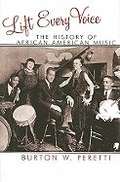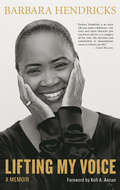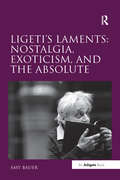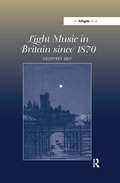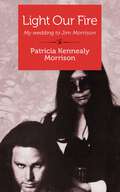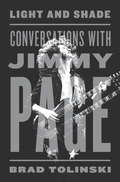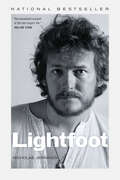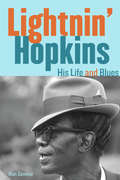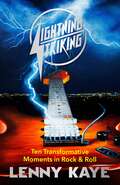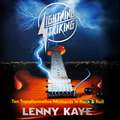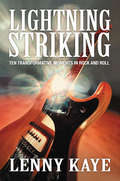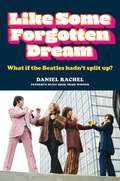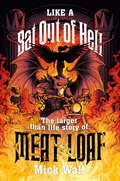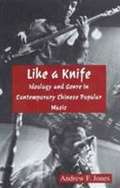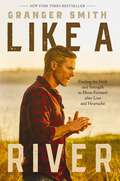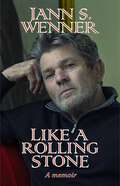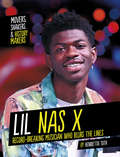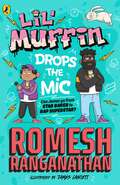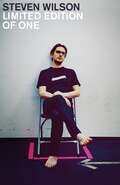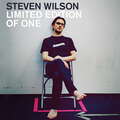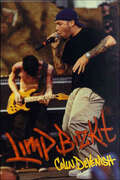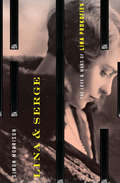- Table View
- List View
Lift Every Voice: The History of African American Music
by Burton W. PerettiSince their enslavement in West Africa and transport to plantations of the New World, black people have made music that has been deeply entwined with their religious, community, and individual identities. Music was one of the most important constant elements of African American culture in the centuries-long journey from slavery to freedom. It also continued to play this role in blacks' post-emancipation odyssey from second-class citizenship to full equality. Lift Every Voice traces the roots of black music in Africa and slavery and its evolution in the United States from the end of slavery to the present day. The music's creators, consumers, and distributors are all part of the story. Musical genres such as spirituals, ragtime, the blues, jazz, gospel, rhythm and blues, rock, soul, and hip-hop-as well as black contributions to classical, country, and other American music forms-depict the continuities and innovations that mark both the music and the history of African Americans. A rich selection of documents help to define the place of music within African American communities and the nation as a whole.
Lifting My Voice: A Memoir
by Kofi Annan Barbara HendricksGrowing up African American in segregated Arkansas in the 1950s, Barbara Hendricks witnessed firsthand the painful struggle for civil rights. After graduation from the Juilliard School of Music, Hendricks immediately won a number of important international prizes, and began performing in recitals and operas throughout the world. A Goodwill Ambassador for the United Nations High Commission for Refugees, she is as devoted to humanitarian work as she is to her music. Always the anti-diva, Hendricks is a down-to-earth and straightforward woman, whether singing Mozart or black spirituals. She challenges stereotypes and puts the music first and presents a warm, engaging, and honest self-portrait of one of the great women of music.
Ligeti's Laments: Nostalgia, Exoticism, And The Absolute
by Amy BauerWhen the Hungarian composer Gy�rgy Ligeti passed away in June 2006, he was widely feted as being one of the greatest composers of our time. His complete published works were recorded during his lifetime and his music continues to inspire a steady stream of performances and scholarship. Ligeti's Laments provides a critical analysis of the composer's works, considering both the compositions themselves and the larger cultural implications of their reception. Bauer both synthesizes and challenges the prevailing narratives surrounding the composer's long career and uses the theme of lament to inform a discussion of specific musical topics, including descending melodic motives, passacaglia and the influence of folk music. But Ligeti 'laments' in a larger sense; his music fuses rigour and sensuality, tradition and the new and influences from disparate high and low cultures, with a certain critical and ironic distance, reflected in his spoken commentary as well as in the substance of his music. The notions of nostalgia, exoticism and the absolute are used to relate works of different eras and genres, along with associated concepts of allegory, melancholy, contemporary subjectivity and the voice.
Light Music in Britain since 1870: A Survey
by Geoffrey SelfIn many ways the history of British light music knits together the social and economic history of the country with that of its general musical heritage. Numerous 'serious' composers from Elgar to Britten composed light music, and the genre adapted itself to incorporate the changing fashions heralded by the rise and fall of music hall, the drawing room ballad, ragtime, jazz and the revue. From the 1950s the recording and broadcasting industries provided a new home for light music as an accompaniment to radio programmes and films. Geoffrey Self deftly handles a wealth of information to illustrate the immense role that light music has played in British culture over the last 130 years. His insightful assessments of the best and the most shameful examples of the genre help to pinpoint its enduring qualities; qualities which enable it to maintain a presence in the face of today's domination by commercial popular music.
Light Our Fire: My Wedding to Jim Morrison
by Patricia Kennealy MorrisonWhat's it like to be married to the superstar lead singer of the Doors? Patricia Kennealy Morrison gives a loving and detailed account of the pagan handfasting ceremony that bound her forever with the legendary rock superstar Jim Morrison. The intimate portrait of Jim that emerges—a tender and vulnerable face that was shown to very few—makes this book essential reading. The reader has the good fortune of meeting Patricia in the process and empathizing with this smart, deeply spiritual professional woman who has fallen hopelessly in love with a young man whose genius has made him famous and whose demons have made him notorious.
Light and Shade
by Brad TolinskiMore than 30 years after disbanding in 1980, Led Zeppelin continues to be celebrated for its artistic achievements, broad musical influence, and commercial success. The band's notorious exploits have been chronicled in bestselling books such as Stephen Davis's Hammer of the Gods. Yet none of the individual members of the band has penned a memoir or cooperated to any degree with the press or a biographer. Iconic guitarist and Led Zeppelin founder, Jimmy Page, is both the band's most reticent member and the one who most fascinates its huge fanbase. For the first time and in his own words, he opens up to journalist Brad Tolinski, exploring in-depth his remarkable life and musical journey.
Lightfoot
by Nicholas JenningsThe definitive, full-access story of the life and songs of Canada's legendary troubadourGordon Lightfoot’s name is synonymous with timeless songs about trains and shipwrecks, rivers and highways, lovers and loneliness. His music defined the folk-pop sound of the 1960s and ‘70s, topped charts and sold millions. He is unquestionably Canada’s greatest songwriter, and an international star who has performed on the world’s biggest stages. While Lightfoot’s songs are well known, the man behind them is elusive. He’s never allowed his life to be chronicled in a book—until now.Biographer Nick Jennings has had unprecedented access to the notoriously reticent musician. Lightfoot takes us deep inside the artist’s world, from his idyllic childhood in Orillia, the wild sixties, and his canoe trips into Canada’s North to his heady times atop the music world. Jennings explores the toll that success took on his personal life—including his troubled relationships, his battle with alcohol and his near-death experiences—and the extraordinary drive and tenacity that pulled him through it all.Rich in voices from fellow musicians, close friends, Lightfoot’s family and the singer’s own reminiscences, the biography tells the stories behind some of his best-known love songs, including “Beautiful” and “Song for a Winter’s Night,” as well as the infidelity and divorce that resulted in classics like “Sundown” and “If You Could Read My Mind.” Kris Kristofferson has called Lightfoot’s songs “some of the most beautiful and lasting music of our time.” Lightfoot is an unforgettable portrait of a treasured singer-songwriter, an artist whose work has been covered by everyone from Joni Mitchell, Barbra Streisand and Nico to Bob Dylan, Elvis Presley and Gord Downie. Revealing and insightful, Lightfoot is both an inspiring story of redemption and an exhilarating read.
Lightnin' Hopkins: His Life and Blues
by Alan GovenarBased on scores of interviews with the artist's relatives, friends, lovers, producers, accompanists, managers, and fans, this brilliant biography reveals a man of many layers and contradictions. Following the journey of a musician who left his family's poor cotton farm at age eight carrying only a guitar, the book chronicles his life on the open road playing blues music and doing odd jobs. It debunks the myths surrounding his meetings with Blind Lemon Jefferson and Texas Alexander, his time on a chain gang, his relationships with women, and his lifelong appetite for gambling and drinking. This volume also discusses his hard-to-read personality; whether playing for black audiences in Houston's Third Ward, for white crowds at the Matrix in San Francisco, or in the concert halls of Europe, Sam Hopkins was a musician who poured out his feelings in his songs and knew how to endear himself to his audience--yet it was hard to tell if he was truly sincere, and he appeared to trust no one. Finally, this book moves beyond exploring his personal life and details his entire musical career, from his first recording session in 1946--when he was dubbed Lightnin'--to his appearance on the national charts and his rediscovery by Mack McCormick and Sam Charters in 1959, when his popularity had begun to wane and a second career emerged, playing to white audiences rather than black ones. Overall, this narrative tells the story of an important blues musician who became immensely successful by singing with a searing emotive power about his country roots and the injustices that informed the civil rights era.
Lightning Striking
by Lenny Kaye'A true testimonial and epic love letter to the soul saving power of rock & roll . . . Read it and be inspired, as I was' Bobby Gillespie'Lenny Kaye has illuminated ten facets of the jewel called rock and roll from a uniquely personal and knowledgeable perspective. He draws from a lifetime of inspiration and experience. A youth plugging in his first electric guitar, a fan taking the dance floor, a propelling player, a humble guardian of history, and the writer I have always known him to be' Patti SmithMemphis, 1954. New Orleans 1957. Philadelphia 1959. Liverpool, 1962. San Francisco 1967. Detroit 1969. New York, 1975. London 1977. Los Angeles 1984 / Norway 1993. Seattle 1991.Rock and roll was birthed in basements and garages, radio stations and dance halls, in cities where unexpected gatherings of artists and audience changed and charged the way music is heard and celebrated, capturing lightning in a bottle. Musician and writer Lenny Kaye explores ten crossroads of time and place that define rock and roll, its unforgettable flashpoints, characters and visionaries, how each generation came to be, how it was discovered by the world. Whether Elvis Presley's Memphis, the Beatles' Liverpool, Patti Smith's New York or Kurt Cobain's Seattle, LIGHTNING STRIKING reveals the communal energy that creates a scene, a guided tour inside style and performance, to see who's on stage, along with the movers and shakers, the hustlers and hangers-on, and why everybody is listening. Grandly sweeping and minutely detailed, informed by Kaye's acclaimed knowledge and experience as a working musician, LIGHTNING STRIKING is an ear-opening insight into our shared musical and cultural history, a carpet ride of rock and roll's most influential movements and moments.
Lightning Striking
by Lenny KayeMemphis, 1954. New Orleans 1957. Philadelphia 1959. Liverpool, 1962. San Francisco 1967. Detroit 1969. New York, 1975. London 1977. Los Angeles 1984 / Norway 1993. Seattle 1991. <p><p>Rock and roll was birthed in basements and garages, radio stations and dance halls, in cities where unexpected gatherings of artists and audience changed and charged the way music is heard and celebrated, capturing lightning in a bottle. Musician and writer Lenny Kaye explores ten crossroads of time and place that define rock and roll, its unforgettable flashpoints, characters and visionaries, how each generation came to be, how it was discovered by the world. <p><p>Whether Elvis Presley's Memphis, the Beatles' Liverpool, Patti Smith's New York or Kurt Cobain's Seattle, LIGHTNING STRIKING reveals the communal energy that creates a scene, a guided tour inside style and performance, to see who's on stage, along with the movers and shakers, the hustlers and hangers-on, and why everybody is listening. Grandly sweeping and minutely detailed, informed by Kaye's acclaimed knowledge and experience as a working musician, LIGHTNING STRIKING is an ear-opening insight into our shared musical and cultural history, a carpet ride of rock and roll's most influential movements and moments.
Lightning Striking: Ten Transformative Moments in Rock and Roll
by Lenny Kaye“We have performed side-by-side on the global stage through half a century…. In Lightning Striking, Lenny Kaye has illuminated ten facets of the jewel called rock and roll from a uniquely personal and knowledgeable perspective.” –Patti SmithAn insider’s take on the evolution and enduring legacy of the music that rocked the twentieth centuryMemphis, 1954. New Orleans 1957. Philadelphia 1959. Liverpool, 1962. San Francisco 1967. Detroit 1969. New York, 1975. London 1977. Los Angeles 1984 / Norway 1993. Seattle 1991.Rock and roll was birthed in basements and garages, radio stations and dance halls, in cities where unexpected gatherings of artists and audience changed and charged the way music is heard and celebrated, capturing lightning in a bottle. Musician and writer Lenny Kaye explores ten crossroads of time and place that define rock and roll, its unforgettable flashpoints, characters and visionaries, how each generation came to be, how it was discovered by the world. Whether describing Elvis Presley’s Memphis, the Beatles’ Liverpool, Patti Smith’s New York or Kurt Cobain’s Seattle, Lightning Striking reveals the communal energy that creates a scene, a guided tour inside style and performance, to see who’s on stage, along with the movers and shakers, the hustlers and hangers-on, and why everybody is listening. Grandly sweeping and minutely detailed, informed by Kaye’s acclaimed knowledge and experience as a working musician, Lightning Striking is an ear-opening insight into our shared musical and cultural history, a carpet ride of rock and roll’s most influential movements and moments.
Like Some Forgotten Dream: What if the Beatles hadn't split up?
by Daniel Rachel***This is the story of the great lost Beatles album.The end of the Beatles wasn't inevitable. It came through miscommunication, misunderstandings and missed opportunities to reconcile.But what if it didn't end? What if just one of those chances was taken, and the Beatles carried on? What if they made one last, great album?In Like Some Forgotten Dream, Daniel Rachel - winner of the prestigious Penderyn Music Book Prize - looks at what could have been. Drawing on impeccable research, Rachel examines the the Fab Four's untimely demise - and from the ashes compiles a track list for an imagined final album, pulling together unfinished demos, forgotten B-sides, hit solo songs, and arguing that together they form the basis of a lost Beatles masterpiece.Compelling and convincing, Like Some Forgotten Dream is a daring re-write of Beatles history, and a tantalising glimpse of what might have been.Praise for Daniel Rachel:Walls Come Tumbling Down:'Superlative...brilliant' - Q Magazine'Triumphant' - The Guardian'Brilliant' - MojoIsle of Noises:'In depth, scholarly' - Q Magazine'Fascinating' - The Guardian / NME'Fantastic, insightful interviews' - Noel GallagherDon't Look Back in Anger:'A-grade, A-list' - The Sunday Times'A rollicking read' - Mail on Sunday'Remarkable' - Art Review'Book of the Week' - The Guardian
Like Some Forgotten Dream: What if the Beatles hadn't split up?
by Daniel Rachel***This is the story of the great lost Beatles album.The end of the Beatles wasn't inevitable. It came through miscommunication, misunderstandings and missed opportunities to reconcile.But what if it didn't end? What if just one of those chances was taken, and the Beatles carried on? What if they made one last, great album?In Like Some Forgotten Dream, Daniel Rachel - winner of the prestigious Penderyn Music Book Prize - looks at what could have been. Drawing on impeccable research, Rachel examines the the Fab Four's untimely demise - and from the ashes compiles a track list for an imagined final album, pulling together unfinished demos, forgotten B-sides, hit solo songs, and arguing that together they form the basis of a lost Beatles masterpiece.Compelling and convincing, Like Some Forgotten Dream is a daring re-write of Beatles history, and a tantalising glimpse of what might have been.Praise for Daniel Rachel:Walls Come Tumbling Down:'Superlative...brilliant' - Q Magazine'Triumphant' - The Guardian'Brilliant' - MojoIsle of Noises:'In depth, scholarly' - Q Magazine'Fascinating' - The Guardian / NME'Fantastic, insightful interviews' - Noel GallagherDon't Look Back in Anger:'A-grade, A-list' - The Sunday Times'A rollicking read' - Mail on Sunday'Remarkable' - Art Review'Book of the Week' - The Guardian
Like a Bat Out of Hell: The Larger than Life Story of Meat Loaf
by Mick Wall'A passionate, pacey tome you should do anything for a copy of' - Kerrang! ****"I never wanted to be a big star. I just wanted to be the biggest at what I do! Powerful, unstoppable, heavy - when that word still meant something good!" - Meat Loaf, as told to Mick Wall Everything in the story of Meat Loaf is big. From the place he was born (Texas); to the family he was born into (his father weighed 22 stone, his uncle weighed over 40 stone, while Meat Loaf himself weighed 17 stone before he was even in his teens); to the sound he made (a colossal collision between Richard Wagner, Phil Spector and Bruce Springsteen); and of course the records he sold - nearly 50 million in Britain and America alone. Now, on the eve of the 40th anniversary of Bat Out of Hell, the album that gave rise to Meat Loaf's astonishing career, and the premiere of Bat Out Of Hell: The Musical, Mick Wall, who has interviewed Meat Loaf on numerous occasions throughout his career, pulls back the curtains to reveal the soft-hearted soul behind the larger-than-life character he created for himself. From a tumultuous childhood with an alcoholic father to the relentless abusive bullying from classmates and their parents alike, nobody could have predicted Meat Loaf's meteoric rise to fame. But when the messianic rock opera Bat Out of Hell was released in 1977, it became one of the biggest albums of all time, selling over 45 million copies worldwide to date. Its release marked the start of a rollercoaster ride of incredible highs and seemingly career-ending lows. By the 80s, Meat Loaf was battling with drug and alcohol addiction and escalating money problems that would eventually lead to a nervous breakdown. But just when it seemed like it was all over, the astonishing success of Bat Out of Hell II and the mega-hit 'I'd Do Anything For Love (But I Won't Do That)' marked an extraordinary new wave of success. Now, Mick Wall will bring this extraordinary story up to date, drawing on the hours he spent with Meat Loaf, both in interviews and on tour, as well as offering up a unique insight from those who have known him best.
Like a Bat Out of Hell: The Larger than Life Story of Meat Loaf
by Mick Wall'A passionate, pacey tome you should do anything for a copy of' - Kerrang! "I never wanted to be a big star. I just wanted to be the biggest at what I do! Powerful, unstoppable, heavy - when that word still meant something good!" - Meat Loaf, as told to Mick Wall Everything in the story of Meat Loaf is big. From the place he was born (Texas); to the family he was born into (his father weighed 22 stone, his uncle weighed over 40 stone, while Meat Loaf himself weighed 17 stone before he was even in his teens); to the sound he made (a colossal collision between Richard Wagner, Phil Spector and Bruce Springsteen); and of course the records he sold - nearly 50 million in Britain and America alone.From a tumultuous childhood with an alcoholic father to the relentless abusive bullying he endured, nobody could have predicted Meat Loaf's meteoric rise to fame. But when the messianic rock opera Bat Out of Hell was released in 1977, it became one of the biggest albums of all time, selling over 45 million copies worldwide to date. Its release marked the start of a rollercoaster ride of incredible highs and seemingly career-ending lows. By the 80s, Meat Loaf was battling with drug and alcohol addiction and escalating money problems. But just when it seemed like it was all over, the astonishing success of Bat Out of Hell II and the mega-hit 'I'd Do Anything For Love (But I Won't Do That)' marked an extraordinary new wave of success. Now, Mick Wall will bring this extraordinary story up to date, drawing on the hours he spent with Meat Loaf, both in interviews and on tour, as well as offering up a unique insight from those who have known him best.
Like a Knife: Ideology and Genre in Contemporary Chinese Popular Music
by Andrew F. JonesLike a Knife is the first comprehensive study of Chinese popular music in Western language. Drawing on extensive interviews with singers, songwriters and critics, as well as cultural, sociological, musical, and textual analysis, the book portrays the disparate ways in which China's state-run popular music industry and the burgeoning underground rock music subculture represented by Cui Jian have been instrumental to the cultural and political struggles that culminated in the Tiananmen democracy movement of 1989. The book examines the links between popular music and contemporary debates about cultural identity and modernization, as well as the close connections between rock music, youth culture, and student protest.
Like a River: Finding the Faith and Strength to Move Forward after Loss and Heartache
by Granger SmithNew York Times, USA Today, Wall Street Journal, Publishers Weekly, ECPA Bestseller'Country music artist Smith debuts with a sensitive and moving recollection of his path through grief. . .In stark, intimate prose, the author candidly renders the realities of suffering while articulating a moving message of renewal. Those seeking a faith-based path through grief will find this instructive and affecting.' -- Publishers WeeklyLike a River, a triumphant story of new life birthed out of tragedy, will teach readers how to face their failures, confront their pain, and connect with God—the true source of life.On June 4th, 2019, country music singer Granger Smith was enjoying a final evening with his kids before heading to Nashville for the CMT Music Awards and his next tour. While helping his daughter London with her gymnastics, his youngest son fell into their pool. Granger did everything he could to get to him, but he was too late. River drowned, and Granger's world shattered.The days, weeks, and months that followed River's death sent Granger on a dark and painful journey. Every time he closed his eyes, he replayed the horrific event in his mind, and every time he opened his computer, he was bombarded by the critique and criticism of people who blamed him for the accident.Despite his best effort to get back on stage with a smile and song, it was all a façade. On the inside he was dying. Fortunately, that's not how his story ended. And now he is compelled to help people all around the world find strength, peace, and hope on the other side of tragedy.Like a River, life is full of twists and turns.Like a River, people pollute our world with their critique and criticism.Like a River, tragic events keep us dammed up.But like a river, we can find the courage to keep moving downstream. Rivers don't run on their own strength; they flow from their source. When we try to keep going on our own, we won't make it, but when we connect to the greater source, we will find the strength and the faith to keep living after loss. This triumphant story of new life birthed out of death will inspire every reader to live Like a River.
Like a Rolling Stone: A Memoir
by Jann S. WennerIn this New York Times bestseller, Rolling Stone founder, co-editor, and publisher Jann Wenner offers a "touchingly honest" and "wonderfully deep" memoir from the beating heart of classic rock and roll (Bruce Springsteen). Jann Wenner has been called by his peers &“the greatest editor of his generation.&” His deeply personal memoir vividly describes and brings you inside the music, the politics, and the lifestyle of a generation, an epoch of cultural change that swept America and beyond. The age of rock and roll in an era of consequence, what will be considered one of the great watersheds in modern history. Wenner writes with the clarity of a journalist and an essayist. He takes us into the life and work of Bob Dylan, John Lennon, Mick Jagger, Bono, and Bruce Springsteen, to name a few. He was instrumental in the careers of Hunter S. Thompson, Tom Wolfe, and Annie Leibovitz. His journey took him to the Oval Office with his legendary interviews with Bill Clinton and Barack Obama, leaders to whom Rolling Stone gave its historic, full-throated backing. From Jerry Garcia to the Dalai Lama, Aretha Franklin to Greta Thunberg, the people Wenner chose to be seen and heard in the pages of Rolling Stone tried to change American culture, values, and morality.Like a Rolling Stone is a beautifully written portrait of one man&’s life, and the life of his generation.
Lil Nas X: Record-Breaking Musician Who Blurs the Lines (Movers, Shakers, and History Makers)
by Henrietta TothLil Nas X became famous in 2019 for the country rap song "Old Town Road." He collaborates with other musicians and aims to defy expectations. Learn more about Lil Nas X's life as a famous musician!
Lil' Muffin Drops the Mic: The brand-new children’s book from comedian Romesh Ranganathan!
by Romesh RanganathanFrom comedy superstar Romesh Ranganathan comes a hilarious and heartfelt tale that proves rap battles and baking muffins really can mix. The perfect story for readers age 8+ and fans of David Baddiel and Adam B Wins the Internet!Ever since his dad left, James can't seem to stop worrying about everything. His favourite hobby, baking, is a fun (and delicious!) distraction, but no matter how many AMAZING brownies he makes, James still feels like there's a missing ingredient in his life . . .Until he discovers rapping, and he's COMPLETELY hooked. It's not long before James starts writing his own raps about everything - from music and cakes to his giant pet rabbit, Graham!So when he hears that grime artist star Brukka is on the hunt for young talent, James starts to wonder: could this be his chance to share his MUFFINS, his MUSIC, and maybe even his feelings with the whole school? If he could only find the confidence . . .Full of laugh-out-loud illustrations from bestselling illustrator James Lancett, this is the children's read of the summer!
Limited Edition of One
by Steven WilsonThe more I thought about it, the more I realised my career has been unusual. How did I manage to do everything wrong but still end up on the front cover of magazines, headlining world tours and achieving Top 5 albums? How did I attract such obsessive and fanatical fans, many of whom take everything I do or say very personally, which is simultaneously flattering but can also be tremendously frustrating? Even this I somehow cultivated without somehow meaning to. My accidental career.Limited Edition of One is unlike any other music book you will ever have read.Part the long-awaited memoir of Steven Wilson: whose celebrated band Porcupine Tree began as teenage fiction before unintentionally evolving into a reality that encompassed Grammy-nominated records and sold-out shows around the world, before he set out for an even more successful solo career.Part the story of a twenty-first century artist who achieved chart-topping mainstream success without ever becoming part of the mainstream. From Abba to Stockhausen, via a collection of conversations and thought pieces on the art of listening, the rules of collaboration, lists of lists, personal stories, professional adventurism (including food, film, TV, modern art), old school rock stardom, how to negotiate an obsessive fanbase and survive on social media, and dream-fever storytelling.
Limited Edition of One
by Steven WilsonThe more I thought about it, the more I realised my career has been unusual. How did I manage to do everything wrong but still end up on the front cover of magazines, headlining world tours and achieving Top 5 albums? How did I attract such obsessive and fanatical fans, many of whom take everything I do or say very personally, which is simultaneously flattering but can also be tremendously frustrating? Even this I somehow cultivated without somehow meaning to. My accidental career.Limited Edition of One is unlike any other music book you will ever have read.Part the long-awaited memoir of Steven Wilson: whose celebrated band Porcupine Tree began as teenage fiction before unintentionally evolving into a reality that encompassed Grammy-nominated records and sold-out shows around the world, before he set out for an even more successful solo career.Part the story of a twenty-first century artist who achieved chart-topping mainstream success without ever becoming part of the mainstream. From Abba to Stockhausen, via a collection of conversations and thought pieces on the art of listening, the rules of collaboration, lists of lists, personal stories, professional adventurism (including food, film, TV, modern art), old school rock stardom, how to negotiate an obsessive fanbase and survive on social media, and dream-fever storytelling.
Limited Edition of One: How to Succeed in the Music Industry Without Being Part of the Mainstream
by Steven WilsonThe more I thought about it, the more I realised my career has been unusual. How did I manage to do everything wrong but still end up on the front cover of magazines, headlining world tours and achieving Top 5 albums? How did I attract such obsessive and fanatical fans, many of whom take everything I do or say very personally, which is simultaneously flattering but can also be tremendously frustrating? Even this I somehow cultivated without somehow meaning to. My accidental career.Limited Edition of One is unlike any other music book you will ever have read.Part the long-awaited memoir of Steven Wilson: whose celebrated band Porcupine Tree began as teenage fiction before unintentionally evolving into a reality that encompassed Grammy-nominated records and sold-out shows around the world, before he set out for an even more successful solo career.Part the story of a twenty-first century artist who achieved chart-topping mainstream success without ever becoming part of the mainstream. From Abba to Stockhausen, via a collection of conversations and thought pieces on the art of listening, the rules of collaboration, lists of lists, personal stories, professional adventurism (including food, film, TV, modern art), old school rock stardom, how to negotiate an obsessive fanbase and survive on social media, and dream-fever storytelling.
Limp Bizkit
by Colin Devenish1999 was quite a year for Limp Bizkit. Their album, "Significant Other," sat atop the Billboard album charts. Rolling Stone hailed them as the lone band that "redefined late-Nineties hard rock." Their Woodstock '99 set is routinely referred to as the hottest moment of the three day concert. All in all, things are definitely happening for this most unique group. Combining rap, metal and the angst filled sentiment of punk rock, Limp Bizkit are the poster-boys for millenium madness.Noted music journalist Colin Devenish goes beyond the chart topping numbers and concert grosses to examine what has turned this rough and tumble bunch from Jacksonville, Florida into the hottest group on the charts.
Lina & Serge: The Love and Wars of Lina Prokofiev
by Simon MorrisonThis account of the renowned composer&’s neglected wife—including her years in a Soviet prison—is &“a story both riveting and wrenching&” (Kirkus Reviews, starred review). Serge Prokofiev was one of the twentieth century&’s most brilliant composers yet is an enigma to historians and his fans. Why did he leave the West and move to the Soviet Union despite Stalin&’s crimes? Why did his astonishing creativity in the 1930s soon dissolve into a far less inspiring output in his later years? The answers can finally be revealed, thanks to Simon Morrison&’s unique and unfettered access to the family&’s voluminous papers and his ability to reconstruct the tragic, riveting life of the composer&’s wife, Lina. Morrison&’s portrait of the marriage of Lina and Serge Prokofiev is the story of a remarkable woman who fought for survival in the face of unbearable betrayal and despair and of the irresistibly talented but heartlessly self-absorbed musician she married. Born to a Spanish father and Russian mother in Madrid at the end of the nineteenth century and raised in Brooklyn, Lina fell in love with a rising-star composer—and defied convention to be with him, courting public censure. She devoted her life to Serge and art, training to be an operatic soprano and following her brilliant husband to Stalin&’s Russia. Just as Serge found initial acclaim—before becoming constricted by the harsh doctrine of socialist-realist music—Lina was at first accepted and later scorned, ending her singing career. Serge abandoned her and took up with another woman. Finally, Lina was arrested and shipped off to the gulag in 1948. She would be held in captivity for eight awful years. Meanwhile, Serge found himself the tool of an evil regime to which he was forced to accommodate himself. The contrast between Lina and Serge is one of strength and perseverance versus utter self-absorption, a remarkable human drama that draws on the forces of art, sacrifice, and the struggle against oppression. Readers will never forget the tragic drama of Lina&’s life, and never listen to Serge&’s music in quite the same way again.
